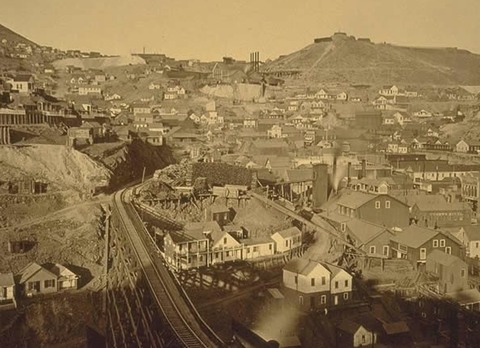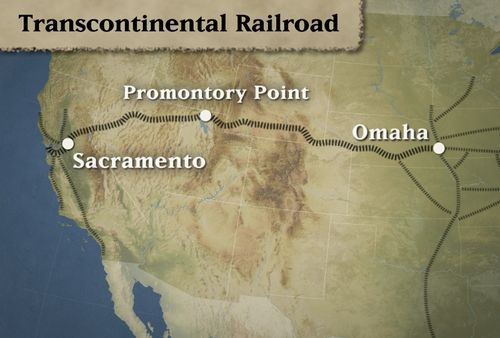US History - Effects of Railroads on West

EQ: What were the results of Mining and Railroads on America?
Do Now: What was America’s expansion from sea to shining sea called?
| Lesson Overview | ||||||||
|---|---|---|---|---|---|---|---|---|
| Utilized | Activity | Time Allocated | Mode of Activity | |||||
| ____ | Do Now | _________ / 2-5 Min | (Individual / Think-Pair-Share / Pair / Group #____) | |||||
| ____ | Mini Lesson | _________/ 15-20 Min | (Individual / Think-Pair-Share / Pair / Group #____) | |||||
| ____ | Activity | _________ / 20-30 Min | (Individual / Think-Pair-Share / Pair / Group #_____) | |||||
| ____ | Discussion/Exit Ticket | _________ / 5-10 Min | (Individual / Think-Pair-Share / Pair / Group #____) | |||||
| ____ | Assessment | _________ / 10-40 Min | (Individual / Think-Pair-Share / Pair / Group #____) | |||||
| ____ | Conferencing | _________ Min | (Individual / Pair / Group #____ / Throughout Class Period) | |||||
Mining in the West

The western portion of the United States was mined sporadically and on a small scale as early as the late 1600's by Spanish miners. However, it was not until the 1848 discovery of gold in California that a relentless pursuit of mineral wealth began in the western states. The California Gold Rush that followed the 1848 discovery was the largest and most important event in the opening of the western frontier, and it set the stage for many more smaller rushes and booms throughout the west.
In the late 1850's, the Pike's Peak Gold Rush in Colorado signaled the first major push into the Rocky Mountains. At about the same time, silver was discovered at the Comstock Lode in western Nevada. In California, Mining was beginning to wane after 10 years of frenzied mining and prospecting and the Comstock discovery resulted in an exodus of miners to the new district. The town of Virginia City would be built at the site of the Comstock lode, which would become one of the greatest ore deposits ever discovered.
By the 1860's prospectors were pushing into every corner of the vast mountainous west in search of riches. Mining towns sprang up in remote places throughout the region. Colorado experienced an enormous silver boom at Leadville in the 1870's. Gold discoveries in the native american territory in the Black Hills of South Dakota would start a new gold rush in the late 1870's. As electrification started in the United States, copper would become a valuable commodity and the great copper mining districts would rise to prominence, the greatest of them at Butte, Montana - possibly the most valuable mining district in the world.
Late major discoveries were made at Cripple Creek in Colorado in the 1890's, and at Goldfield, Nevada in the first decade of the twentieth century. Cripple creek would become one of the world's great mining districts. Goldfield would become the greatest example of boom and bust in the history of the mining west and by the 1920's much of it lay in ruins.
Transcontinental Railroad

The First Transcontinental Railroad in the United States was built in the 1860s, linking the well developed railway network of the Eastern coast with rapidly growing California. The main line was officially completed on May 10, 1869. The vast number of people who traveled the line, and the network that followed, set the USA on the path to economic abundance. It also ended the centuries old way of life of the Naive Americans and greatly altered the environment.
The rail line was an important goal of President Abraham Lincoln, fostered during the early portion of his term and completed four years after his death. The building of the railroad was motivated in part to bind California to the Union during the American Civil War. The railroad is considered by some to be the greatest technological feat of the 19th century. The transcontinental railroad replaced the slower and more dangerous wagon trains, Pony Express and stagecoach lines that crossed the country by land and the equally difficult sea journey around the southern tip of South America.
The route followed the well established Oregon, Mormon and California Trails. The new line began in Omaha, Nebraska, followed the Platte River, crossed the Rocky Mountains at South Pass in Wyoming and then through northern Utah and Nevada before crossing the Sierras to Sacramento, California. Additional track was laid to connect Denver, Colorado and Salt Lake City, Utah and other cities not directly on the route.
The Central Pacific laid 690 miles (1,110 km) of track, starting in Sacramento, and the Union Pacific laid 1,087 miles (1,749 km) of track, starting in Omaha. The two lines connected at Promontory Summit, Utah.
Activities
Lesson PowerPoint:
- Transcontinental Railroad & Mining
- Write a paragraph of the effects of the railroads and mining on the American West. (5 – 6 Sentences)